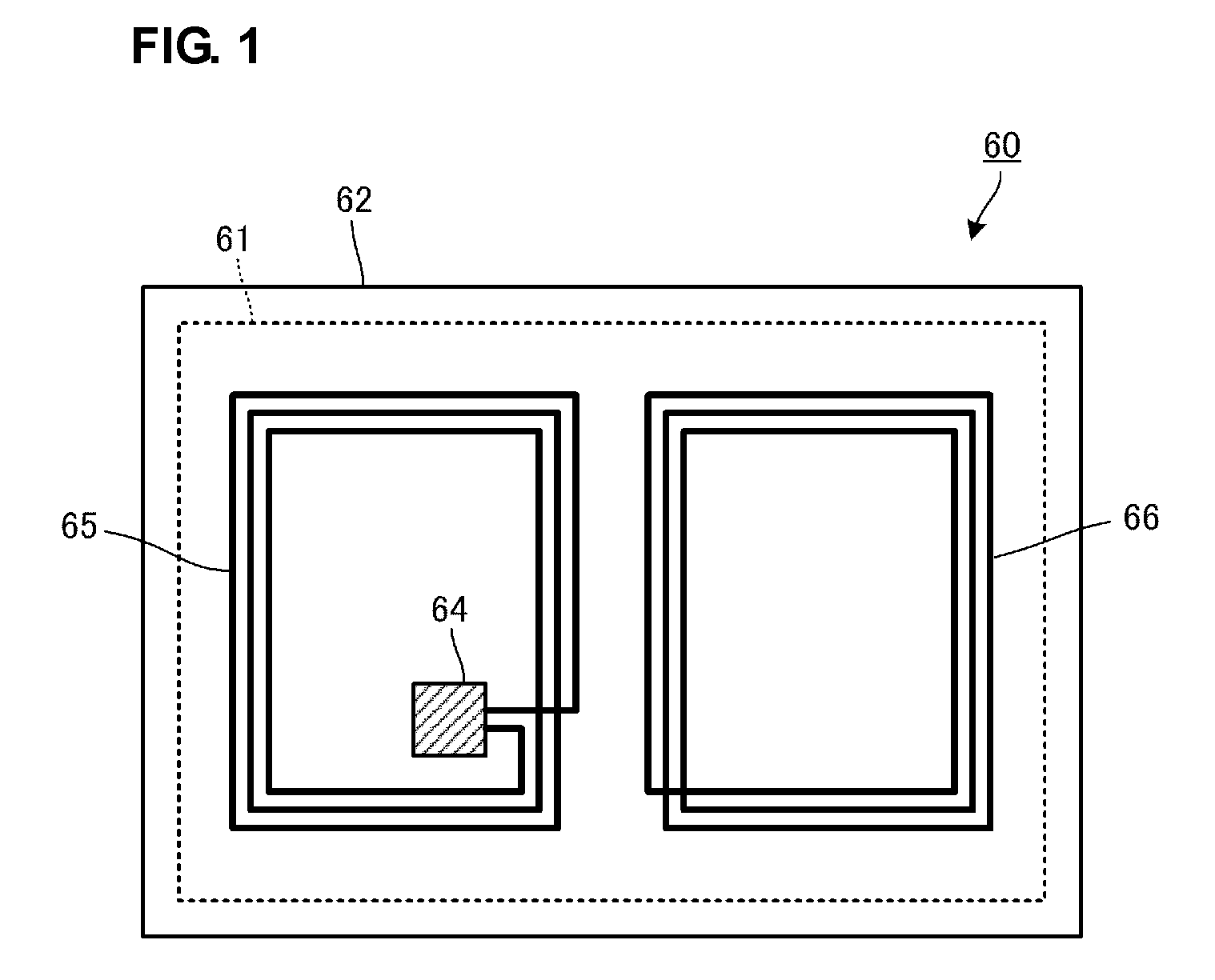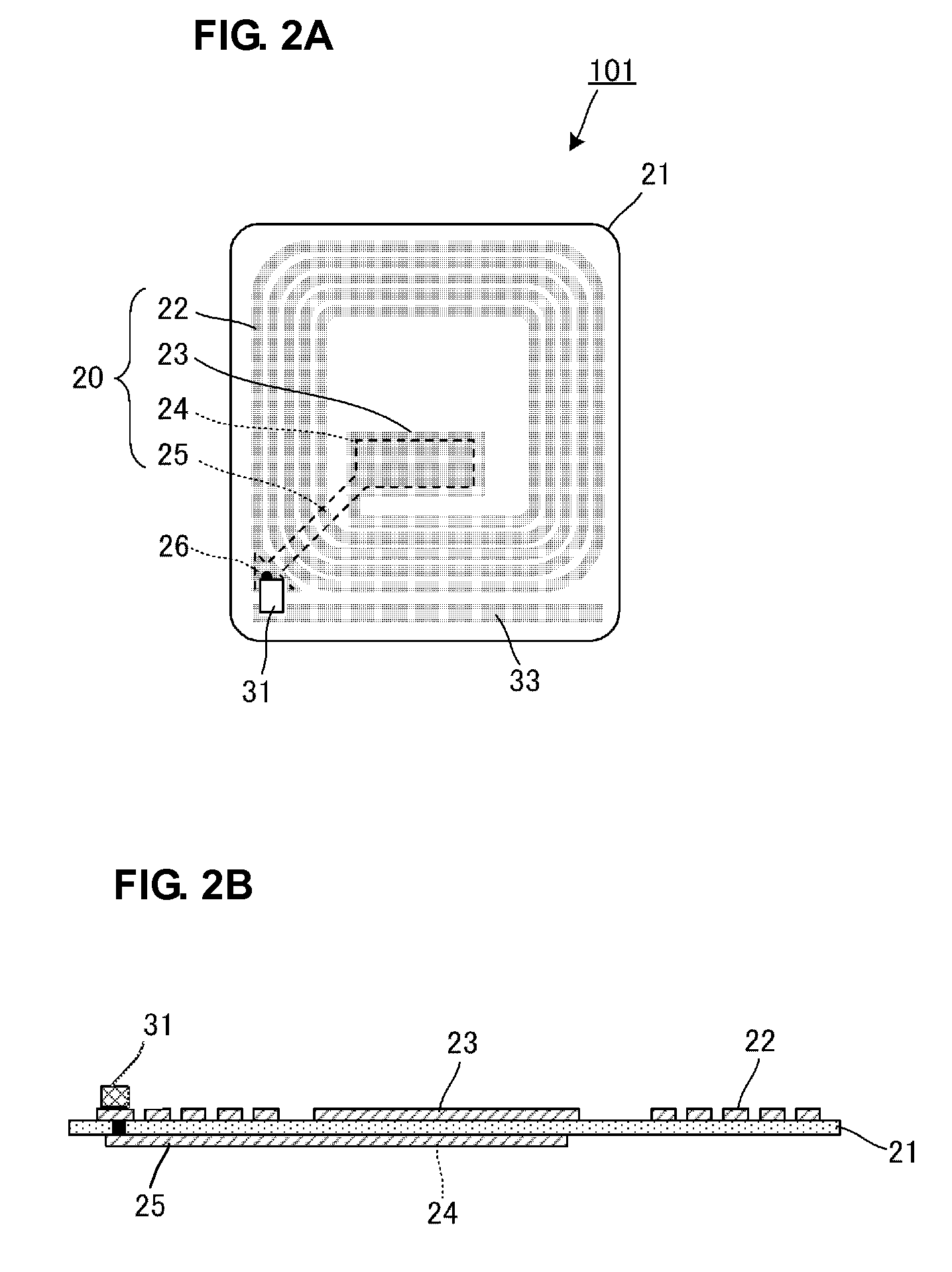Wireless IC device
a technology of ic device and wire, which is applied in the direction of protective material radiating elements, near-field systems using receivers, instruments, etc., can solve the problems of increasing return loss, disadvantageous size of combination tags described in japanese unexamined patent application publication no. 2007-18067, etc., and achieve excellent radiation characteristics.
- Summary
- Abstract
- Description
- Claims
- Application Information
AI Technical Summary
Benefits of technology
Problems solved by technology
Method used
Image
Examples
first preferred embodiment
[0031]FIGS. 2A and 2B illustrate the structure of a wireless IC device according to a first preferred embodiment. FIG. 2A is a plan view, and FIG. 2B is a cross-sectional view of a principal portion of the wireless IC device. A wireless IC device 101 includes a substrate (insulating sheet) 21 and a wireless IC 31 including a wireless IC chip mounted on the substrate 21. Various electrodes are also disposed on the substrate 21.
[0032]In FIGS. 2A and 2B, a desired electrode pattern including a conductor such as copper and aluminum is formed on the substrate 21 composed of a resin film such as polyethylene terephthalate (PET) and polypropylene (PP) in the wireless IC device 101. More specifically, a copper foil or an aluminum foil is patterned by etching using a resin sheet on which the copper foil or the aluminum foil is applied.
[0033]As shown in FIGS. 2A and 2B, a substantially spiral line electrode portion 22 and a first capacitance electrode portion 23 connected to the inner end of ...
second preferred embodiment
[0042]FIGS. 4A to 4C are plan views of wireless IC devices according to a second preferred embodiment. The wireless IC device shown in FIGS. 2A and 2B has the linear radiating electrode 33 disposed along a side of the substantially spiral line electrode portion 22 and along a side of the substrate 21. The wireless IC devices shown in FIGS. 4A to 4C have radiating electrodes whose shapes are different from that shown in FIGS. 2A and 2B. In FIG. 4A, a radiating electrode 33a extends along a side of a line electrode portion 22 and along a side of a substrate 21 so as to be turned back.
[0043]In FIG. 4B, a radiating electrode 33b linearly extends along a side of the substrate 21 in a direction away from a radiating / resonating electrode 20.
[0044]In FIG. 4C, a radiating electrode 33c extends along two sides of the substrate 21 so as to have a substantially L-shaped configuration.
[0045]In FIGS. 4A to 4C, structures and operations other than those described above are the same as those in the...
third preferred embodiment
[0048]FIGS. 5A and 5B illustrate the structure of a wireless IC device according to a third preferred embodiment. FIG. 5A is a plan view, and FIG. 5B is a cross-sectional view of a principal part of the wireless IC device. In the wireless IC device shown in FIGS. 2A and 2B, electrodes are disposed on the top and bottom surfaces of the substrate 21 such that capacitance is formed at the capacitance electrode portions that oppose each other with the substrate 21 therebetween. In the wireless IC device shown in FIGS. 5A and 5B, a circuit is formed by utilizing only the top surface of a substrate 21. That is, a substantially spiral line electrode portion 22 and a first capacitance electrode portion 23 connected to the inner end of the line electrode portion 22 are disposed on the top surface of the substrate 21, and an insulating layer 27 is disposed on the electrodes. A second capacitance electrode portion 24 is disposed on the top surface of the insulating layer 27 at a position oppos...
PUM
 Login to View More
Login to View More Abstract
Description
Claims
Application Information
 Login to View More
Login to View More - R&D
- Intellectual Property
- Life Sciences
- Materials
- Tech Scout
- Unparalleled Data Quality
- Higher Quality Content
- 60% Fewer Hallucinations
Browse by: Latest US Patents, China's latest patents, Technical Efficacy Thesaurus, Application Domain, Technology Topic, Popular Technical Reports.
© 2025 PatSnap. All rights reserved.Legal|Privacy policy|Modern Slavery Act Transparency Statement|Sitemap|About US| Contact US: help@patsnap.com



